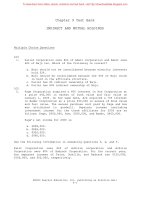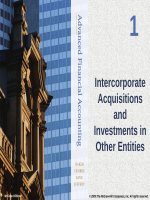Advanced financial accounting by baker chapter 09
Bạn đang xem bản rút gọn của tài liệu. Xem và tải ngay bản đầy đủ của tài liệu tại đây (3.82 MB, 41 trang )
9
Consolidation
Ownership
Issues
McGraw-Hill/Irwin
© 2009 The McGraw-Hill Companies, Inc. All rights reserved.
General Overview
•
The following topics are discussed in this
chapter:
1. Subsidiary preferred stock outstanding
2. Changes in the parent’s ownership interest in the
subsidiary
3. Multiple ownership levels
4. Reciprocal or mutual ownership
5. Subsidiary stock dividends
9-2
Subsidiary Preferred Stock Outstanding
• Preferred stockholders normally have
preference over common shareholders with
respect to dividends and the distribution of
assets in a liquidation
– The right to vote usually is withheld
– Special attention must be given to the claim of
a subsidiary’s preferred shareholders on the net
assets of the subsidiary
9-3
Subsidiary Preferred Stock Outstanding
• Consolidation with subsidiary preferred stock
outstanding
– The amount of subsidiary stockholders’ equity
accruing to preferred shareholders must be
determined before dealing with the elimination
of the intercompany common stock ownership
– If the parent holds some of the subsidiary’s
preferred stock, its portion of the preferred
stock interest must be eliminated
– Any portion of the subsidiary’s preferred stock
interest not held by the parent is assigned to
the noncontrolling interest
9-4
Subsidiary Preferred Stock Outstanding
- Illustration
1. Peerless Products acquires 80 percent of Special Foods’ common stock on
January 1, 20X1, at its book value of $240,000 and accounts for the
investment using the basic equity method. At the date of combination, the
fair value of Special Foods’ common stock held by the noncontrolling
shareholders is equal to its book value of $60,000.
2. Peerless earns income from its own operations of $140,000 in 20X1 and
declares dividends of $60,000.
3. Special Foods reports net income of $50,000 in 20X1 and declares
common dividends of $30,000.
4. On January 1, 20X1, immediately after the combination, Special Foods
issues $100,000 of 12 percent preferred stock at par value, none of which
is purchased by Peerless. The regular $12,000 preferred dividend is paid in
20X1.
9-5
Subsidiary Preferred Stock Outstanding
- Illustration
• Allocation of Special Foods’ net income
Of the total $50,000 of net income reported by Special Foods for 20X1,
$12,000 ($100,000 x .12) is assigned to the preferred shareholders as their
current dividend. Peerless records its share of the remaining amount:
Income assigned to the noncontrolling interest for 20X1:
9-6
Subsidiary Preferred Stock Outstanding
- Illustration
Computation and allocation of consolidated net income:
The workpaper to prepare consolidated financial statements at the end of
20X1 appears in Figure 9–1 in the text.
9-7
Subsidiary Preferred Stock Outstanding
- Illustration
9-8
Subsidiary Preferred Stock Outstanding
• Subsidiary preferred stock held by parent
– Because the preferred stock held by the parent
is within the consolidated entity, it must be
eliminated when consolidated financial
statements are prepared
– Any income from the preferred stock recorded
by the parent also must be eliminated
9-9
Subsidiary Preferred Stock Outstanding
- Illustration
Peerless acquires 60 percent of Special Foods’ $100,000 par value, 12
percent preferred stock for $60,000 when issued on January 1, 20X1. During
20X1 dividends of $12,000 are declared on the preferred stock. Peerless
recognizes $7,200 of dividend income from its investment in preferred stock,
and the remaining $4,800 is paid to the holders of the other preferred shares.
9-10
Subsidiary Preferred Stock Outstanding
- Illustration
9-11
Subsidiary Preferred Stock Outstanding
• Subsidiary preferred stock with special
provisions
– The provisions of the preferred stock
agreement must be examined to determine the
portion of the subsidiary’s stockholders’ equity
to be assigned to the preferred stock interest
•
•
•
•
Cumulative dividend provision
Noncumulative preferred stock
Preferred stock participation features
Preferred stocks that are callable
9-12
Illustration of Subsidiary Preferred
Stock with Special Features
1. Special Foods issues $100,000 par value 12 percent preferred stock on
January 1, 20X0. It is cumulative, nonparticipating, and callable at 105.
2. No dividends are declared on the preferred stock during 20X0.
3. On January 1, 20X1, Peerless Products acquires 80 percent of Special
Foods’ common stock for $240,000, when the fair value of the
noncontrolling interest in Special Foods’ common stock is $60,000.
4. On January 1, 20X1, Peerless acqiures 60 percent of the preferred stock
for $61,000.
5. Stockholders’ equity accounts of Special Foods on January 1, 20X1 follow:
9-13
Illustration of Subsidiary Preferred
Stock with Special Features
Peerless acquires 60 percent of Special Foods’ $100,000 par value, 12
percent preferred stock for $60,000 when issued on January 1, 20X1. During
20X1 dividends of $12,000 are declared on the preferred stock. Peerless
recognizes $7,200 of dividend income from its investment in preferred stock,
and the remaining $4,800 is paid to the holders of the other preferred shares.
This amount is apportioned between Peerless and the noncontrolling
shareholders:
9-14
Illustration of Subsidiary Preferred
Stock with Special Features
Because the preferred stock interest exceeds the par value by $17,000, the
portion of Special Foods’ retained earnings accruing to the common
shareholders is reduced by that amount. Therefore, Special Foods’ common
stockholders have a total claim on the company’s net assets as follows:
Because the book value of Special Foods’ common stock is only $283,000 on
January 1, 20X1, a differential arises:
9-15
Illustration of Subsidiary Preferred
Stock with Special Features
9-16
Changes in Parent Company
Ownership
• Parent’s purchase of additional shares from
nonaffiliate
– Effects of multiple purchases of a subsidiary’s
stock on the consolidation process are
illustrated in the following example:
Assume that on January 1, 20X0, Special Foods has $200,000 of common
stock outstanding and retained earnings of $60,000. During 20X0, 20X1, and
20X2, Special Foods reports the following information:
9-17
Changes in Parent Company
Ownership - Illustration
Peerless Products purchases its 80 percent interest in Special Foods in
several blocks, as follows:
All of the differential relates to land held by Special Foods. Note that Peerless
does not gain control of Special Foods until January 1, 20X2.
9-18
Changes in Parent Company
Ownership - Illustration
The investment account on Peerless’s books includes the following amounts
through 20X1:
9-19
Changes in Parent Company
Ownership - Illustration
When Peerless gains control of Special Foods on January 1, 20X2, assume
that the fair value of the 30 percent equity interest it already holds in Special
Foods is $111,000, and the fair value of Special Foods’ 20 percent remaining
noncontrolling interest is $74,000. The book value of Special Foods as a whole
on that date is $320,000. Under FASB 141R, the differential at the date of
combination is computed as follows:
Because all of the differential relates to land, it is not amortized or written off
either on Peerless’s books or for consolidation.
9-20
Changes in Parent Company
Ownership - Illustration
Under FASB 141R, Peerless must remeasure the equity interest it already
held in Special Foods to its fair value at the date of combination and recognize
a gain or loss for the difference between the fair value and its carrying amount:
The total balance of the investment account on Peerless’s books immediately
after the combination is:
9-21
Changes in Parent Company
Ownership - Illustration
Because Peerless Products gains control of Special Foods on January 1,
20X2, consolidated statements are prepared for the year 20X2.
9-22
Changes in Parent Company
Ownership
• Parent’s sale of subsidiary shares to
nonaffiliate
– When a parent sells some shares of a
subsidiary but continues to hold a controlling
interest, FASB 160 makes clear that this is
considered to be an equity transaction and no
gain or loss may be recognized in consolidated
net income
– An adjustment is required to the amount
assigned to the noncontrolling interest to reflect
its change in ownership of the subsidiary
9-23
Changes in Parent Company
Ownership
– The difference between the fair value of the
consideration exchanged and the adjustment to
the noncontrolling interest results in an
adjustment to the stockholders’ equity
attributable to the controlling interest
– Some parent companies might choose to
recognize a gain on their separate books
• A better alternative is to avoid recognizing a gain
that later will have to be eliminated and instead
recognize an increase in additional paid-in capital
9-24
Changes in Parent Company
Ownership
• Subsidiary’s sale of additional shares to
nonaffiliate
– Increases the total stockholders’ equity of the
consolidated entity by the amount received by
the subsidiary from the sale
– Increases the subsidiary’s total shares
outstanding and reduces the percentage
ownership held by the parent
– The dollar amount assigned to the
noncontrolling interest in the consolidated
financial statements increases
9-25









